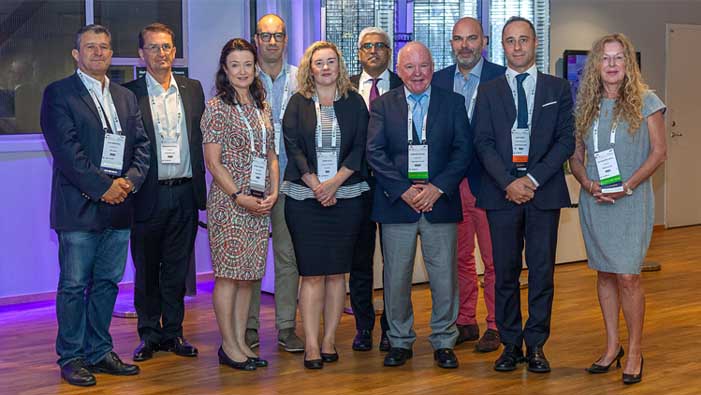Main photo: ICS Standardisation Chairs: (top) Tage Hald, Jens Andersen, Anders Mattiassen, Derek Griffiths; (bottom) Philip van Kerrebroeck, Dirk de Ridder, Marcus Drake, Bernie Haylen
Standardisation of lower urinary tract (LUT) and pelvic floor (PF) terminology remains a key strength of the International Continence Society (ICS); the standardisation documents are ICS’s “crown jewels”. In 2019, the 1134 terms in current ICS documents were collated onto an easy-to-use instantaneous digital platform, the ICS Glossary, comprising the descriptor and category for each term with access to all the source documents. No other Society in the field and few other specialties anywhere in medicine would have its standardisation of terminology so comprehensively under control. Everyone in this multidisciplinary Society can speak the same language at all meetings and forums with many more documents being developed and hundreds of new definitions coming.

Original ICS Standardisation Committee
Standardisation was an early priority of the early ICS with the first Standardisation Committee formed in 1972 under the Chairmanship of Tage Hald with Committee Members: Patrick Bates, Hansjorg Melchior, Art Sterling, David Rowan, Derek Griffiths and Eric Glen. Between 1972 and 1980, there were three Reports of the Terminology for LUT dysfunction (1974 – AGM Mainz, 1976, 1980). A fourth Report was produced in 1983, adding Torsten Sundin, David Thomas, Michael Torrens, Richard Turner-Warwick and Norman Zinner to the authors of the 1980 Report.
The original Committee (1980 Report) retired in 1983 with Jens Thorup Andersen (1983-1991) taking over Chair. Anders Mattiasson (1991-1998) followed, then Derek Griffiths (1998-2000) and Philip van Kerrebroeck (2000-2007).
The 1998 LUT Report (Abrams et al) collated the 6 LUT/PF Reports till that time. Other documents leading up to 2002 LUT Report include: (i) Technical aspects of urodynamic equipment (Rowan et al 1987); (ii) LUT rehabilitation techniques (Andersen et al 1992); (iii) Pelvic organ prolapse (POP) and PF dysfunction (Bump et al 1996); (iv) LUT function: Pressure-flow studies (Griffiths et al 1997); (v) Standardisation of outcome studies: general principles (Mattiasson et al 1998); (vi) Adult women with symptoms of LUT dysfunction (Lose et al 1998); (vii) Standardisation of definitions of LUT dysfunction in children (Norgaard et al 1998); (viii) Neurogenic LUT dysfunction (Stohrer et al 1999); (ix) Standardisation of urodynamic ambulatory monitoring. (Van Waalwijk van Doorn et al 2000); (x) Treatment of males with symptoms of LUT dysfunction (Nordling et al 1998) and (xi) Nocturia (2002) – Van Kerrebroek et al and four ICS outcome reports. The 2002 Terminology for LUT dysfunction Report (Abrams et al.) incorporated male and female terminology and became the most referenced terminology document in ICS and LUT dysfunction history (by 2020, over 11000 citations in 2 Journals).
Standardisation documents between 2002 and 2010 include: (i) Good Urodynamic practices (2002) - Schaefer et al; and (ii) Pelvic floor muscle function and dysfunction (2005) - Messelink et al.
In 2007, an excellent working relationship developed between ICS Standardisation Steering Committee Chair (2007-2010), Dirk de Ridder and then Chair International Urogynecological Association (IUGA) Terminology and Standardization Committee Chair (2008-2014), Bernard Haylen, which lead to the publication of the IUGA-ICS Terminology for Pelvic Floor Dysfunction (PFD - Haylen, de Ridder et al), the most cited urogynecology terminology publication (second most cited ICS publication – over 3000 citations), in January 2010. This female-specific document, notably added 3 “most common” diagnoses (bladder oversensitivity, recurrent urinary tract infections and voiding dysfunction to the three existing female diagnoses in the 2002 Report (urodynamic stress incontinence, detrusor overactivity, POP). It was the forerunner to further joint IUGA-ICS publications and a template for other ICS publications.
The IUGA-ICS standardisation and terminology relationship was maintained till 2017 with 7 other joint documents initiated: (i) Complications for prostheses and grafts (2011) – Haylen et al.; (ii) Reporting outcomes of surgical procedures for POP (2012) – Toozs-Hobson et al.; (iii) Complications of native tissue surgery (2012) – Haylen et al.; (iv) Pelvic organ prolapse (2016) – Haylen et al.; (v) Conservative and non-pharmacological management of female PFD (2017) – Bo et al; (vi) Female anorectal dysfunction (2017) – Sultan et al; (vii) Sexual health in women with PFD (2018) – Rogers et al.
There were 2 non-IUGA-ICS documents between 2010 and 2016 when Marcus Drake (2000-2016) was SSC Chair: (i) Update on Good urodynamic practice in (2016) - Rosier et al; (ii) Chronic pelvic pain (2017) – Doggweiler et al.
Under current Chair, Bernard Haylen (2016-2020), the emphasis was to update male-specific terminology, whilst initiating further female-specific and other projects. Adult neurogenic lower urinary tract dysfunction (2018) – Gazewski et al. and Nocturnal lower urinary tract function (2019) – Hashim et al, were brought to completion. The first core male terminology for LUT and PF symptoms and dysfunction was published in February 2019 – D'Ancona, Haylen et al with 390 definitions of which 211 (54%) were new. Other male projects initiated were (i) Male LUT surgical terminology; (ii) Male anorectal terminology; (iii) Conservative management of male LUT dysfunction and (iv) Sexual health in men with LUT dysfunction.

ICS Standardisation Committee Gothenburg Meeting
In February 2019, following the completion of the male terminology paper, the ICS Glossary (www.ics.org/glossary) was launched (Haylen – compiler, Glossary Editor). In 2020, subject to a world viral emergency, published documents should add new definitions to the Glossary. These include those for (i) Single-use absorbent pads (Fader et al); (ii) Male LUT surgical terminology (Abranches-Monteiro, Hamid et al); (iii) Male anorectal dysfunction (Schizas et al) and (iv) Female pelvic floor fistula (Elneil, Romanzi, Goh et al); (v) Pelvic floor muscle function and dysfunction (Frawley, Shelly, Morin et al). There are additional ongoing reports being developed on: (i) Obstetric trauma; (ii) Transitional urology; (iii) Nursing aspects of LUT dysfunction.
Standardisation in ICS is going from strength to strength. ICS totally dominates this area, providing an example to other Societies and other Specialties the importance of defining as much of the areas relevant to the Society as possible. This has only been possible firstly by a culture within ICS that standardisation is one of the most important aspects of the Society. It relies on the dedication of those Chairs and members of the ICS Standardisation Steering Committees and members of Working Groups over the last 50 years. Each Chair and the members of each Committee have provided a legacy for those that follow. In the main, excellent cooperation has occurred in developing Reports; strong debate, however, hasn’t been omitted along the way. The final note copies that in the 40-year anniversary report: “The standardisation reports are living documents and modification and change is always possible in the future”. They have enhanced the stature of the ICS as well as the citation index of its Journal, Neurourology and Urodynamics.
Article by Bernard Haylen